Entity Framework Code First主外键关系映射约定
本篇随笔目录:
在关系数据库中,不同表之间往往不是全部都单独存在,而是相互存在关联的。两个不同表之间可以存在外键依赖关系,一个表自身也可以有自反关系(表中的一个字段引用主键,从而也是外键字段)。
Entity Framework Code First默认多重关系的一些约定规则:
一对多关系:两个类中分别包含一个引用和一个集合属性,也可以是一个类包含另一个类的引用属性,或一个类包含另一个类的集合属性。如在本篇接下来用到的例子Category类和Product类,要使得Category与Product之间具有一对多关系,Entity Framework Code First可以有3种体现方式:
1>、在Category类中定义ICollection<Product> Products集合属性,同时在Product类中定义Category Category引用属性。
2>、仅在Category类中定义ICollection<Product> Products集合属性。
3>、仅在Product类中定义Category Category引用属性。
多对多关系:两个类分别包含对方的一个集合属性。如在本篇接下来用到的例子User类和Role类,要使得User与Role之间具有多对多关系,即一个用户可以属于多个角色,一个角色可以有多个用户,则需要在User类中需要定义一个ICollection<Role> Roles集合属性,同时在Role类中需要定义一个ICollection<User> Users属性。
一对一关系:两个类分别包含对方的一个引用属性。如在本篇接下来用到的例子User类和UserProfile类,要使得User与UserProfile之间具有一对一关系,则需要在User类中定义一个UserProfile UserProfile的引用属性,同时在UserProfile类中定义一个User User的引用属性。
下面具体描述Entity Framework Code First生成外键的默认约定,并通过实例展示Entity Framework Code First处理一个表及多个表之间的关系。
1、外键列名默认约定
Entity Framework Code First在根据默认约定创建外键时,外键列的名称存在3种方式。在《Programming Entity Framework Code First》一书中,给出的3种外键列名的约定方式是:[Target Type Key Name], [Target Type Name] + [Target Type Key Name], or [Navigation Property Name] + [Target Type Key Name],对应的中文翻译为:[目标类型的键名],[目标类型名称]+[目标类型键名称],或[引用属性名称]+[目标类型键名称]。
Entity Framework Code First外键默认约束生成的外键在分别满足3种不同的条件下,外键列名有3种不同的命名规则。且经过测试这3种不同的外键名称命名之间存在优先级:[目标类型的键名] > [引用属性名称]+[目标类型键名称] > [目标类型名称]+[目标类型键名称]。接下来以Product类及Category类为例,分别测试外键列名称的3中不同生成方式,Category与Product为一对多关系。
1>、[目标类型的键名]
这种方式为要求在Product表中外键列名与Category表中的主键列名相同,所以也就要求在Product类中有定义与Category类中作为主键的属性。如在Category类中主键属性为CategoryID,则需要在Product类中也定义一个CategoryID的属性。
文件Category.cs:
using System;
using System.Collections.Generic;
using System.Linq;
using System.Text; namespace Portal.Entities
{
public class Category
{
public int CategoryID { get; set; }
public string CategoryName { get; set; } public virtual ICollection<Product> Products { get; set; }
}
}
文件Product.cs:
using System;
using System.Collections.Generic;
using System.Linq;
using System.Text; namespace Portal.Entities
{
public class Product
{
public int ProductID { get; set; }
public string ProductName { get; set; }
public decimal UnitPrice { get; set; }
public int CategoryID { get; set; } public virtual Category Category { get; set; }
}
}
说明:在Category类及Product类中的引用属性及集合属性前加virtual修饰,为的是Entity Framework Code First的延迟加载功能。不使用virtual修饰,在Category类的一个实例要查询包含的Product实例时,将不会启用延迟加载。当然Entity Framework Code First延迟加载并不是必须的,所以virtual修饰符也可以不加。
在定义以上两个类之后,不再添加任何的Entity Framework Code First与数据库的映射配置,运行之后,生成的数据表结构为:

从生成的Categories与Products表结构可以看出,在Products表中的外键CategoryID与引用的表Categories主键名称相同。跟踪Entity Framework Code First生成数据表的执行脚本可以看到具体生成外键的SQL语句。
ALTER TABLE [dbo].[Products] ADD CONSTRAINT [FK_dbo.Products_dbo.Categories_CategoryID] FOREIGN KEY ([CategoryID]) REFERENCES [dbo].[Categories] ([CategoryID]) ON DELETE CASCADE
同时,从生成外键的脚本还能看出一点,Entity Framework Code First生成外键是启用级联删除功能的。即当删除Categories表中一条记录时,数据库会自动联带删除Products表中属于该类别的记录。
在数据库中生成的Products表,查看外键FK_dbo.Products_dbo.Categories_CategoryID属性,其的确有启用级联删除功能。
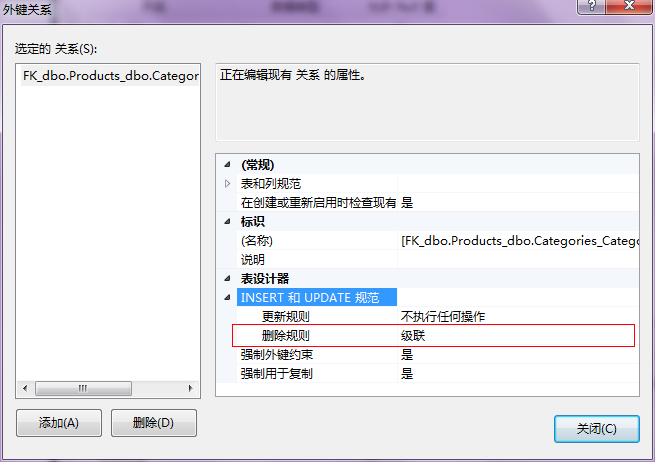
2>、[目标类型名称]+[目标类型键名称]
这种方式要求在Product表中外键列名为Category类名+Category类中键名称,即在Products表中生成的外键名称为Category_CategoryID。示例:在Category类中添加ICollection<Product> Products的集合属性,而在Product类中不做任何与Category关联的代码,也不定义CategoryID属性。
文件Category.cs:
using System;
using System.Collections.Generic;
using System.Linq;
using System.Text; namespace Portal.Entities
{
public class Category
{
public int CategoryID { get; set; }
public string CategoryName { get; set; } public virtual ICollection<Product> Products { get; set; }
}
}
文件Product.cs:
using System;
using System.Collections.Generic;
using System.Linq;
using System.Text; namespace Portal.Entities
{
public class Product
{
public int ProductID { get; set; }
public string ProductName { get; set; }
public decimal UnitPrice { get; set; }
}
}
在定义以上两个类之后,不再添加任何的Entity Framework Code First与数据库的映射配置,运行之后,生成的数据表结构为:
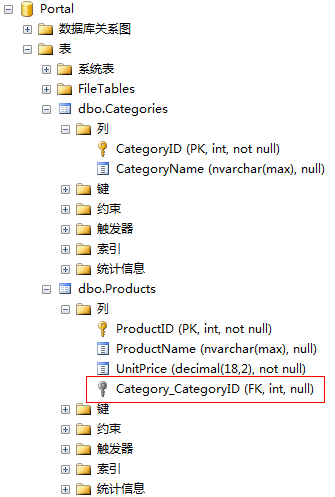
3>、[引用属性名称]+[目标类型键名称]
这种方式为要求在Product表中外键列名为在Product类中引用Category的属性名称 + Category类的主键名称。如:在Product类中定义一个Category属性Cat,则生成的外键名称为Cat_CategoryID。
文件Category.cs:
using System;
using System.Collections.Generic;
using System.Linq;
using System.Text; namespace Portal.Entities
{
public class Category
{
public int CategoryID { get; set; }
public string CategoryName { get; set; }
}
}
文件Product.cs:
using System;
using System.Collections.Generic;
using System.Linq;
using System.Text; namespace Portal.Entities
{
public class Product
{
public int ProductID { get; set; }
public string ProductName { get; set; }
public decimal UnitPrice { get; set; } /// <summary>
/// 这里为演示,使用Cat作为Category的缩写。
/// </summary>
public virtual Category Cat { get; set; }
}
}
在定义以上两个类之后,不再添加任何的Entity Framework Code First与数据库的映射配置,运行之后,生成的数据表结构为:
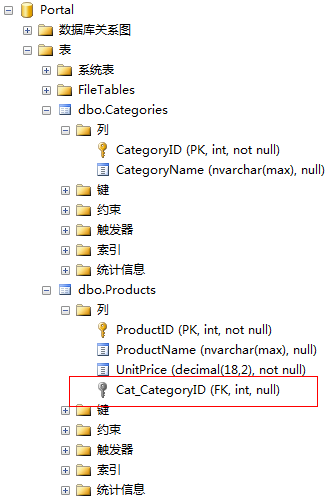
关于3种不同的外键名称命名之间存在优先级:[目标类型的键名] > [引用属性名称]+[目标类型键名称] > [目标类型名称]+[目标类型键名称]的测试方法:
[目标类型的键名]的最高优先级:只要在Product类中定义了CategoryID的属性,在Products表中生成的外键列名都只会为CategoryID。
[引用属性名称]+[目标类型键名称] > [目标类型名称]+[目标类型键名称]:只要在Product类中定义Cat属性,不管Category类中是否定义Products属性,生成的Products表中外键都只会是Cat_CategoryID。
2、一对多关系
Entity Framework Code First在根据定义的类生成数据表时,数据表之间的外键关系及所生成的外键列名有默认的约定。但这种约定同样可以进行修改,如将不满足默认外键约定的属性来作为生成表的外键。示例:Category类与Product类,在Product类中定义一个属性CatID,要将CatID属性作为Product的引用Category的外键,而按照Entity Framework Code First的默认约定是不会的。要做到需要的CatID作为外键,同样可以使用Data Annotations和Fluent API两种方式实现。
1>、Data Annotations方式
文件类Category.cs:
using System;
using System.Collections.Generic;
using System.Linq;
using System.Text; namespace Portal.Entities
{
public class Category
{
public int CategoryID { get; set; }
public string CategoryName { get; set; } public virtual ICollection<Product> Products { get; set; }
}
}
文件类Product.cs:
using System;
using System.Collections.Generic;
using System.Linq;
using System.Text; using System.ComponentModel.DataAnnotations.Schema; namespace Portal.Entities
{
public class Product
{
public int ProductID { get; set; }
public string ProductName { get; set; }
public decimal UnitPrice { get; set; } public int CatID { get; set; } [ForeignKey("CatID")]
public virtual Category Category { get; set; }
}
}
在定义以上两个类之后,不再添加任何的Entity Framework Code First与数据库的映射配置,运行之后,生成的数据表结构为:

查看Products表的外键咧CatID引用关系:

其中,在Product类中,为设置CatID属性为外键的代码为:
public int CatID { get; set; }
[ForeignKey("CatID")]
public virtual Category Category { get; set; }
该段实现方式还可以改为:
[ForeignKey("Category")]
public int CatID { get; set; }
public virtual Category Category { get; set; }
2>、Fluent API方式
文件类Category.cs:
using System;
using System.Collections.Generic;
using System.Linq;
using System.Text; namespace Portal.Entities
{
public class Category
{
public int CategoryID { get; set; }
public string CategoryName { get; set; } public virtual ICollection<Product> Products { get; set; }
}
}
文件类Product.cs:
using System;
using System.Collections.Generic;
using System.Linq;
using System.Text; namespace Portal.Entities
{
public class Product
{
public int ProductID { get; set; }
public string ProductName { get; set; }
public decimal UnitPrice { get; set; } public int CatID { get; set; } public virtual Category Category { get; set; }
}
}
文件类PortalContext.cs:
using System;
using System.Collections.Generic;
using System.Linq;
using System.Text; using System.Data.Entity; using Portal.Entities; namespace Portal
{
public class PortalContext : DbContext
{
static PortalContext()
{
Database.SetInitializer(new DropCreateDatabaseIfModelChanges<PortalContext>());
} public DbSet<Category> Categories { get; set; }
public DbSet<Product> Products { get; set; } protected override void OnModelCreating(DbModelBuilder modelBuilder)
{
modelBuilder.Entity<Category>()
.HasMany(t => t.Products)
.WithRequired(t => t.Category)
.HasForeignKey(d => d.CatID);
modelBuilder.Entity<Product>()
.HasRequired(t => t.Category)
.WithMany(t => t.Products)
.HasForeignKey(d => d.CatID);
}
}
}
说明:在PortalContext.cs的OnModelCreating方法中,对两个实体类Category及Product均添加了Fluent API形式的关系配置。对于Entity Framework Code First而言,两个实体类之间的关系,可以两个类中均添加关系映射配置,也可以只对其中任意一个实体类添加关系映射配置。即在PortalContext.cs的OnModelCreating方法中可以只包含Category或只包含Product类的关系映射配置。这里从Entity Framework Code First的使用经验及技巧,建议将实体类之间关系映射配置在包含外键的类中。即OnModelCreating中只添加对Product实体类的关系映射配置,这样做有一个好处,当Category有多个表引用它时,可以将外键均配置在引用它的实体类中,从而降低Category类的复杂度,同时也有益于代码的维护。
即在PortalContext.cs的OnModelCreating方法只需下面的定义即可:

protected override void OnModelCreating(DbModelBuilder modelBuilder)
{
modelBuilder.Entity<Product>()
.HasRequired(t => t.Category)
.WithMany(t => t.Products)
.HasForeignKey(d => d.CatID);
}

Entity Framework Code First根据一对多关系关系生成的外键引用约束默认是有级联删除的,可以通过以下方式禁用Category与Product之间的级联删除。

protected override void OnModelCreating(DbModelBuilder modelBuilder)
{
modelBuilder.Entity<Product>()
.HasRequired(t => t.Category)
.WithMany(t => t.Products)
.HasForeignKey(d => d.CatID)
.WillCascadeOnDelete(false);
}

也可以在Entity Framework Code First生成的全部表中都统一设置禁用一对多级联删除。
protected override void OnModelCreating(DbModelBuilder modelBuilder)
{
modelBuilder.Conventions.Remove<OneToManyCascadeDeleteConvention>();
}
虽然Entity Framework Code First是可以支持外键列名自定义的,但在实际的项目中,更多的外键列名称还是与所引用表的主键列名相同。即在Category表中主键为CategoryID,在Product表中外键列名称还是为CategoryID。
Entity Framework Code First的Fluent API配置实体类与表的映射关系,还可以将所有的实体类与表的映射全部写在一个类中,这样可以方便代码的维护。
文件类Category.cs:
using System;
using System.Collections.Generic;
using System.Linq;
using System.Text; namespace Portal.Entities
{
public partial class Category
{
public Category()
{
this.Products = new List<Product>();
} public int CategoryID { get; set; }
public string CategoryName { get; set; } public virtual ICollection<Product> Products { get; set; }
}
}
文件类CategoryMap.cs,用于描述Category类与生成的表之间的映射关系:
using System;
using System.Collections.Generic;
using System.Linq;
using System.Text; using System.ComponentModel.DataAnnotations.Schema;
using System.Data.Entity.ModelConfiguration; using Portal.Entities; namespace Portal.Mapping
{
public class CategoryMap : EntityTypeConfiguration<Category>
{
public CategoryMap()
{
// Primary Key
this.HasKey(t => t.CategoryID); // Properties
this.Property(t => t.CategoryName)
.IsRequired()
.HasMaxLength(); // Table & Column Mappings
this.ToTable("Category");
this.Property(t => t.CategoryID).HasColumnName("CategoryID");
this.Property(t => t.CategoryName).HasColumnName("CategoryName");
}
}
}
文件类Product.cs:
using System;
using System.Collections.Generic; namespace Portal.Entities
{
public partial class Product
{
public int ProductID { get; set; }
public int CategoryID { get; set; }
public string ProductName { get; set; }
public Nullable<decimal> UnitPrice { get; set; }
public Nullable<int> Quantity { get; set; } public virtual Category Category { get; set; }
}
}
文件类ProductMap.cs,用于描述Product类与生成的表之间的映射关系:
using System;
using System.Collections.Generic;
using System.Linq;
using System.Text; using System.ComponentModel.DataAnnotations.Schema;
using System.Data.Entity.ModelConfiguration; using Portal.Entities; namespace Portal.Mapping
{
public class ProductMap : EntityTypeConfiguration<Product>
{
public ProductMap()
{
// Primary Key
this.HasKey(t => t.ProductID); // Properties
this.Property(t => t.ProductName)
.IsRequired()
.HasMaxLength(); // Table & Column Mappings
this.ToTable("Product");
this.Property(t => t.ProductID).HasColumnName("ProductID");
this.Property(t => t.CategoryID).HasColumnName("CategoryID");
this.Property(t => t.ProductName).HasColumnName("ProductName");
this.Property(t => t.UnitPrice).HasColumnName("UnitPrice");
this.Property(t => t.Quantity).HasColumnName("Quantity"); // Relationships
this.HasRequired(t => t.Category)
.WithMany(t => t.Products)
.HasForeignKey(d => d.CategoryID);
}
}
}
PortalContext.cs的OnModelCreating方法:
protected override void OnModelCreating(DbModelBuilder modelBuilder)
{
modelBuilder.Configurations.Add(new CategoryMap());
modelBuilder.Configurations.Add(new ProductMap());
}
3、一对一关系
在一对一关系中,两个表均有各自的主键,但要看哪个表的主键同时作为外键引用另一个表的主键。示例以User类与UserProfile类作为两个具有一对一关系的类,其中User类包含作为主键的UserID属性,UserProfile类包含作为主键的ProfileID的属性。
1>、Data Annotations方式
文件类User.cs:
using System;
using System.Collections.Generic; using System.ComponentModel.DataAnnotations;
using System.ComponentModel.DataAnnotations.Schema; namespace Portal.Entities
{
public partial class User
{
[Key]
public int UserID { get; set; }
public string UserName { get; set; }
public string Password { get; set; }
public Nullable<bool> IsValid { get; set; } public virtual UserProfile UserProfile { get; set; }
}
}
文件类UserProfile.cs:
using System;
using System.Collections.Generic; using System.ComponentModel.DataAnnotations;
using System.ComponentModel.DataAnnotations.Schema; namespace Portal.Entities
{
public partial class UserProfile
{
[Key]
[ForeignKey("User")]
public int ProfileID { get; set; }
public string Name { get; set; }
public Nullable<bool> Sex { get; set; }
public Nullable<DateTime> Birthday { get; set; }
public string Email { get; set; }
public string Telephone { get; set; }
public string Mobilephone { get; set; }
public string Address { get; set; }
public Nullable<DateTime> CreateDate { get; set; } public virtual User User { get; set; }
}
}
在定义以上两个类之后,不再添加任何的Entity Framework Code First与数据库的映射配置,运行之后,生成的数据表结构为:

在生成的数据表中,UserProfile表中的主键ProfileID同时也作为外键引用User表中的主键UserID。
修改文件类User.cs:
using System;
using System.Collections.Generic; using System.ComponentModel.DataAnnotations;
using System.ComponentModel.DataAnnotations.Schema; namespace Portal.Entities
{
public partial class User
{
[Key]
[ForeignKey("UserProfile")]
public int UserID { get; set; }
public string UserName { get; set; }
public string Password { get; set; }
public Nullable<bool> IsValid { get; set; } public virtual UserProfile UserProfile { get; set; }
}
}
修改文件类UserProfile.cs:
using System;
using System.Collections.Generic; using System.ComponentModel.DataAnnotations;
using System.ComponentModel.DataAnnotations.Schema; namespace Portal.Entities
{
public partial class UserProfile
{
[Key]
public int ProfileID { get; set; }
public string Name { get; set; }
public Nullable<bool> Sex { get; set; }
public Nullable<DateTime> Birthday { get; set; }
public string Email { get; set; }
public string Telephone { get; set; }
public string Mobilephone { get; set; }
public string Address { get; set; }
public Nullable<DateTime> CreateDate { get; set; } public virtual User User { get; set; }
}
}
则实体类执行之后生成的数据表User主键UserID将同时作为外键引用UserProfile表的主键ProfileID。
2>、Fluent API方式
Fluent API设置实体类生成的表引用与被引用通过WithRequiredPrincipal、WithRequiredDependent及WithOptionalPrincipal、WithOptionalDependent来设置,使用Principal属性的实体类将被另外的实体类生成的表引用,使用Dependent属性的实体类将引用另外的实体类。
文件类User.cs:
using System;
using System.Collections.Generic; using System.ComponentModel.DataAnnotations;
using System.ComponentModel.DataAnnotations.Schema; namespace Portal.Entities
{
public partial class User
{
public int UserID { get; set; }
public string UserName { get; set; }
public string Password { get; set; }
public Nullable<bool> IsValid { get; set; } public virtual UserProfile UserProfile { get; set; }
}
}
映射文件类UserMap.cs:
using System;
using System.Collections.Generic;
using System.Linq;
using System.Text; using System.ComponentModel.DataAnnotations.Schema;
using System.Data.Entity.ModelConfiguration; using Portal.Entities; namespace Portal.Mapping
{
public class UserMap : EntityTypeConfiguration<User>
{
public UserMap()
{
// Primary Key
this.HasKey(t => t.UserID); // Properties
this.Property(t => t.UserName)
.HasMaxLength(); this.Property(t => t.Password)
.HasMaxLength(); // Table & Column Mappings
this.ToTable("User");
this.Property(t => t.UserID).HasColumnName("UserID");
this.Property(t => t.UserName).HasColumnName("UserName");
this.Property(t => t.Password).HasColumnName("Password");
this.Property(t => t.IsValid).HasColumnName("IsValid");
}
}
}
文件类UserProfile.cs:
using System;
using System.Collections.Generic; namespace Portal.Entities
{
public partial class UserProfile
{
public int UserID { get; set; }
public string Name { get; set; }
public Nullable<bool> Sex { get; set; }
public Nullable<DateTime> Birthday { get; set; }
public string Email { get; set; }
public string Telephone { get; set; }
public string Mobilephone { get; set; }
public string Address { get; set; }
public Nullable<DateTime> CreateDate { get; set; } public virtual User User { get; set; }
}
}
映射文件类UserProfileMap.cs:
using System;
using System.Collections.Generic;
using System.Linq;
using System.Text; using System.ComponentModel.DataAnnotations.Schema;
using System.Data.Entity.ModelConfiguration; using Portal.Entities; namespace Portal.Mapping
{
public class UserProfileMap : EntityTypeConfiguration<UserProfile>
{
public UserProfileMap()
{
// Primary Key
this.HasKey(t => t.UserID); // Properties
this.Property(t => t.UserID)
.HasDatabaseGeneratedOption(DatabaseGeneratedOption.None); this.Property(t => t.Name)
.IsRequired()
.HasMaxLength(); this.Property(t => t.Email)
.IsRequired()
.HasMaxLength(); this.Property(t => t.Telephone)
.HasMaxLength(); this.Property(t => t.Mobilephone)
.HasMaxLength(); this.Property(t => t.Address)
.HasMaxLength(); // Table & Column Mappings
this.ToTable("UserProfile");
this.Property(t => t.UserID).HasColumnName("UserID");
this.Property(t => t.Name).HasColumnName("Name");
this.Property(t => t.Sex).HasColumnName("Sex");
this.Property(t => t.Birthday).HasColumnName("Birthday");
this.Property(t => t.Email).HasColumnName("Email");
this.Property(t => t.Telephone).HasColumnName("Telephone");
this.Property(t => t.Mobilephone).HasColumnName("Mobilephone");
this.Property(t => t.Address).HasColumnName("Address");
this.Property(t => t.CreateDate).HasColumnName("CreateDate"); // Relationships
this.HasRequired(t => t.User)
.WithRequiredDependent(t => t.UserProfile);
}
}
}
在以上实体类及实体映射类执行以后,生成的数据表结构如下:
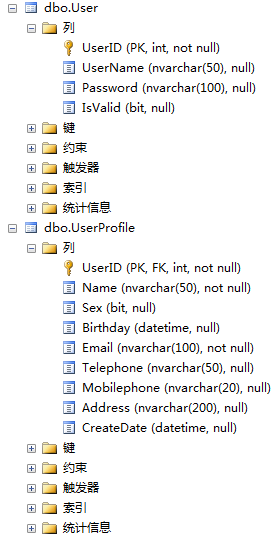
在生成的表结构中,UserProfile表中的主键UserID同时也作为外键引用User表的主键UserID。若修改UserProfileMap.cs如下,则生成的表结构User表的主键UserID将作为你外键引用UserProfile表的主键UserID。
using System;
using System.Collections.Generic;
using System.Linq;
using System.Text; using System.ComponentModel.DataAnnotations.Schema;
using System.Data.Entity.ModelConfiguration; using Portal.Entities; namespace Portal.Mapping
{
public class UserProfileMap : EntityTypeConfiguration<UserProfile>
{
public UserProfileMap()
{
// Primary Key
this.HasKey(t => t.UserID); // Properties
this.Property(t => t.UserID)
.HasDatabaseGeneratedOption(DatabaseGeneratedOption.None); this.Property(t => t.Name)
.IsRequired()
.HasMaxLength(); this.Property(t => t.Email)
.IsRequired()
.HasMaxLength(); this.Property(t => t.Telephone)
.HasMaxLength(); this.Property(t => t.Mobilephone)
.HasMaxLength(); this.Property(t => t.Address)
.HasMaxLength(); // Table & Column Mappings
this.ToTable("UserProfile");
this.Property(t => t.UserID).HasColumnName("UserID");
this.Property(t => t.Name).HasColumnName("Name");
this.Property(t => t.Sex).HasColumnName("Sex");
this.Property(t => t.Birthday).HasColumnName("Birthday");
this.Property(t => t.Email).HasColumnName("Email");
this.Property(t => t.Telephone).HasColumnName("Telephone");
this.Property(t => t.Mobilephone).HasColumnName("Mobilephone");
this.Property(t => t.Address).HasColumnName("Address");
this.Property(t => t.CreateDate).HasColumnName("CreateDate"); // Relationships
this.HasRequired(t => t.User)
.WithRequiredPrincipal(t => t.UserProfile);
}
}
}
4、多对多关系
Entity Framework Code First在根据定义的多对多关系的类生成数据表时,除了生成实体类定义的属性表之外,还会生成一个中间表。用于体现两个实体表之间的多对多的关系。示例实体类User与Role为多对多关系,一个用户可以属于多个角色,一个角色可以包含多个用户。
文件类User.cs:
using System;
using System.Collections.Generic; namespace Portal.Entities
{
public partial class User
{
public int UserID { get; set; }
public string UserName { get; set; }
public string Password { get; set; }
public Nullable<bool> IsValid { get; set; } public virtual ICollection<Role> Roles { get; set; }
}
}
文件类Role.cs:
using System;
using System.Collections.Generic; namespace Portal.Entities
{
public partial class Role
{
public Role()
{
this.Users = new List<User>();
} public int RoleID { get; set; }
public string RoleName { get; set; } public virtual ICollection<User> Users { get; set; }
}
}
在定义以上两个类之后,不再添加任何的Entity Framework Code First与数据库的映射配置,运行之后,生成的数据表结构为:

从以上的表结构中,可以看出,实体类运行之后,除了生成Users表和Roles表之外,还生成了RoleUsers表作为中介表,体现Users表和Roles表之间的多对多关联关系。中介表RoleUsers的字段生成规则按照 [目标类型名称]+[目标类型键名称] 的约定。
Entity Framework Code First根据默认约定生成的多对多关联关系的表时,默认启用多对多的数据级联删除,可以添加代码进行禁用。
protected override void OnModelCreating(DbModelBuilder modelBuilder)
{
// 禁用多对多关系表的级联删除
modelBuilder.Conventions.Remove<ManyToManyCascadeDeleteConvention>();
}
FluentAPI实现方式:
文件类User.cs:
using System;
using System.Collections.Generic; namespace Portal.Entities
{
public partial class User
{
public int UserID { get; set; }
public string UserName { get; set; }
public string Password { get; set; }
public Nullable<bool> IsValid { get; set; } public virtual ICollection<Role> Roles { get; set; }
}
}
映射文件类UserMap.cs:
using System.ComponentModel.DataAnnotations.Schema;
using System.Data.Entity.ModelConfiguration; using Portal.Entities; namespace Portal.Mapping
{
public class UserMap : EntityTypeConfiguration<User>
{
public UserMap()
{
// Primary Key
this.HasKey(t => t.UserID); // Properties
this.Property(t => t.UserName)
.HasMaxLength(); this.Property(t => t.Password)
.HasMaxLength(); // Table & Column Mappings
this.ToTable("User");
this.Property(t => t.UserID).HasColumnName("UserID");
this.Property(t => t.UserName).HasColumnName("UserName");
this.Property(t => t.Password).HasColumnName("Password");
this.Property(t => t.IsValid).HasColumnName("IsValid");
}
}
}
文件类Role.cs:
using System;
using System.Collections.Generic; namespace Portal.Entities
{
public partial class Role
{
public int RoleID { get; set; }
public string RoleName { get; set; } public virtual ICollection<User> Users { get; set; }
}
}
映射文件类RoleMap.cs:
using System.ComponentModel.DataAnnotations.Schema;
using System.Data.Entity.ModelConfiguration; using Portal.Entities; namespace Portal.Mapping
{
public class RoleMap : EntityTypeConfiguration<Role>
{
public RoleMap()
{
// Primary Key
this.HasKey(t => t.RoleID); // Properties
this.Property(t => t.RoleName)
.HasMaxLength(); // Table & Column Mappings
this.ToTable("Role");
this.Property(t => t.RoleID).HasColumnName("RoleID");
this.Property(t => t.RoleName).HasColumnName("RoleName"); // Relationships
this.HasMany(t => t.Users)
.WithMany(t => t.Roles)
.Map(m =>
{
m.ToTable("UserRole");
m.MapLeftKey("RoleID");
m.MapRightKey("UserID");
});
}
}
}
运行之后生成的表结构:
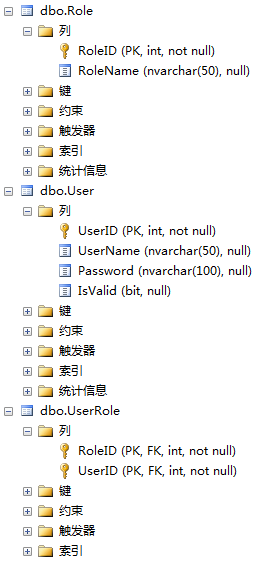
5、一对多自反关系
一对多自反关系,即一个表存在一个外键列引用自身的主键。在项目中,最常见的一对多自反关系为分类表,分类表通过一个ParentID列保存引用主键,已实现无限级递归。
Fluent API实现方式:
文件类Category.cs:
using System;
using System.Collections.Generic; namespace Portal.Entities
{
public class Category
{
public int CategoryID { get; set; }
public int CategoryNo { get; set; }
public string CategoryName { get; set; }
public Nullable<int> ParentID { get; set; }
public virtual Category Parent { get; set; }
public virtual ICollection<Category> Children { get; set; }
}
}
映射文件类CategoryMap.cs:
using System.ComponentModel.DataAnnotations.Schema;
using System.Data.Entity.ModelConfiguration; using Portal.Entities; namespace Portal.Mapping
{
public class CategoryMap : EntityTypeConfiguration<Category>
{
public CategoryMap()
{
// Primary Key
this.HasKey(t => t.CategoryID); // Properties
this.Property(t => t.CategoryName)
.IsRequired()
.HasMaxLength(); // Table & Column Mappings
this.ToTable("Category");
this.Property(t => t.CategoryID).HasColumnName("CategoryID");
this.Property(t => t.CategoryNo).HasColumnName("CategoryNo");
this.Property(t => t.CategoryName).HasColumnName("CategoryName");
this.Property(t => t.ParentID).HasColumnName("ParentID"); // Relationships
this.HasOptional(t => t.Parent)
.WithMany(t => t.Children)
.HasForeignKey(d => d.ParentID);
}
}
}
以上代码在运行之后,生成的数据表:
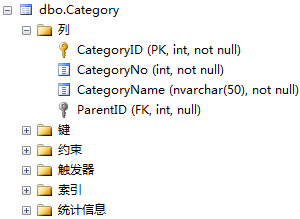
6、多对多自反关系
多对多关系示例:Family中一条记录可能有多个Parents,也可能有多个Children。
文件类Family.cs:
using System;
using System.Collections.Generic; namespace Portal.Entities
{
/// <summary>
/// Family表多对多自反关系
/// </summary>
public partial class Family
{
public Family()
{
this.Parents = new List<Family>();
this.Children = new List<Family>();
} public int FamilyID { get; set; }
public string Name { get; set; }
public Nullable<bool> Sex { get; set; }
public Nullable<System.DateTime> Birthday { get; set; }
public virtual ICollection<Family> Parents { get; set; }
public virtual ICollection<Family> Children { get; set; }
}
}
映射文件类FamilyMap.cs:
using System.ComponentModel.DataAnnotations.Schema;
using System.Data.Entity.ModelConfiguration; using Portal.Entities; namespace Portal.Mapping
{
public class FamilyMap : EntityTypeConfiguration<Family>
{
public FamilyMap()
{
// Primary Key
this.HasKey(t => t.FamilyID); // Properties
this.Property(t => t.Name)
.HasMaxLength(); // Table & Column Mappings
this.ToTable("Family");
this.Property(t => t.FamilyID).HasColumnName("FamilyID");
this.Property(t => t.Name).HasColumnName("Name");
this.Property(t => t.Sex).HasColumnName("Sex");
this.Property(t => t.Birthday).HasColumnName("Birthday"); // Relationships
this.HasMany(t => t.Parents)
.WithMany(t => t.Children)
.Map(m =>
{
m.ToTable("FamilyRelationship");
m.MapLeftKey("ParentID");
m.MapRightKey("ChildID");
});
}
}
}
Family类及映射配置类,在运行之后生成的数据表结构:
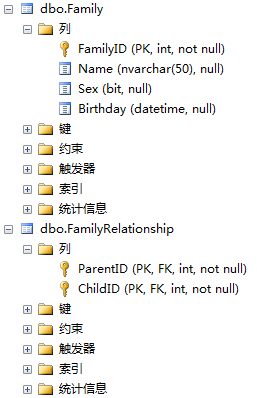
在上面的表结构中,指定Family之间的中介表为FamilyRelationship,其中FamilyRelationship的两个字段ParentID及ChildID均引用Familyi表中的FamilyID作为外键。可能在实际的项目过程中,出现这种多对多自反引用关系的情况比较少见。
Entity Framework Code First主外键关系映射约定的更多相关文章
- Entity Framework 实体间的外键关系
EF 默认是开户级联删除的,这此规则将会删除非空外键和多对多的关系,如果 在数据库上下文中的实体模型类 存在着 级联引用和多重删除路径,那么EF就抛出 级联引用和多重删除路径的异常. Introduc ...
- 通过SQL脚本来查询SQLServer 中主外键关系
在SQLServer中主外键是什么,以及主外键如何创建,在这里就不说了,不懂的可以点击这里,这篇文章也是博客园的博友写的,我觉得总结的很好: 此篇文章主要介绍通过SQL脚本来查看Sqlserver中主 ...
- MySQL创建数据表并建立主外键关系
为mysql数据表建立主外键需要注意以下几点: 需要建立主外键关系的两个表的存储引擎必须是InnoDB. 外键列和参照列必须具有相似的数据类型,即可以隐式转换的数据类型. 外键列和参照列必须创建索引, ...
- SQL SERVER中获取表间主外键关系
sql server 2008中的主外键关系获取方式: 转自:http://www.cnblogs.com/ke10/archive/2012/06/11/2544655.html SELECT OB ...
- SQL Server语句创建数据库和表——并设置主外键关系
简单的创建数据库的 SQL 语句: use master go if exists(select * from sysdatabases where name='Test') begin select ...
- Sql Server有主外键关系时添加、删除数据
当表之间有主外键关系时删除数据会被约束,添加.删除失败 解决办法,我们可以先把主外键关系的检查约束给关掉 → 然后删除数据 → 之后再把约束打开 查询出关掉所有外键约束的语句 SELECT 'ALTE ...
- EntityFramework Core 迁移忽略主外键关系
前言 本文来源于一位公众号童鞋私信我的问题,在我若加思索后给出了其中一种方案,在此之前我也思考过这个问题,借此机会我稍微看了下,目前能够想到的也只是本文所述方案. 为何要忽略主外键关系 我们不仅疑惑为 ...
- Android Ormlite 学习笔记2 -- 主外键关系
以上一篇为例子,进行主外键的查询 定义Users.java 和 Role.java Users -- Role 关系为:1对1 即父表关系 Role -- Users 关系为:1对多 即子表关系 下面 ...
- SQL Server数据库中导入导出数据及结构时主外键关系的处理
2015-01-26 软件开发中,经常涉及到不同数据库(包括不同产品的不同版本)之间的数据结构与数据的导入导出.处理过程中会遇到很多问题,尤为突出重要的一个问题就是主从表之间,从表有外检约束,从而导致 ...
随机推荐
- SQL 增加或删除一列
SQL 增加或删除一列 alter table tablename drop column columnname;alter table tabelname add columnname varcha ...
- POJ 1001 Exponentiation 模拟小数幂
模拟小数幂 小数点位 pos 非零末位 e 长度 len 只有三种情况 pos > len pos < e e < pos < len #include <iostrea ...
- BestCoder Round #36 (hdu5200)Strange Class(离线)
转载请注明出处: http://www.cnblogs.com/fraud/ ——by fraud Trees Time Limit: 2000/1000 MS (Java/Othe ...
- Hbase写数据,存数据,读数据的详细过程
Client写入 -> 存入MemStore,一直到MemStore满 -> Flush成一个StoreFile,直至增长到一定阈值 -> 出发Compact合并操作 -> 多 ...
- otf VS ttf images
- inline-block样式间距
原始问题和解决方法请参考 淘宝UED官方博客:inline-block 前世今生 布局时采用行内块display:inline-block,发现元素之间有空隙,原因是由于空白字符引起的,详细见上面链接 ...
- 启动两个tomcat
因为项目的种种原因,必须启动两个tomcat测试 于是复制tomcat,改端口,报错,到日志看,发现shutdow端口也需要改 总结 server.xml改两个地方的端口 <Server por ...
- 去掉Eclipse打开后定期弹出Usage Data Upload对话框
Eclipse 的 UDC 老定期蹦出来说要上传使用数据到 eclipse 官网服务器去除方法: 1.删除 eclipse/plugins 目录下以 org.eclipse.epp.usagedata ...
- yii CMenu的配置(导航栏)
给主键的li 和a标签添加元素$this->myMenu = array( 'id'=>'myMenu', 'items'=>array( array( 'label'=>'H ...
- CoFun 1613 单词连接
Description Stan有N个不同的单词,这天,Stan新结交的两个朋友来他这里玩,Stan作为主人,他需要送给他们单词,但由于Stan不能偏心,所以Stan给每个单词一个权值v_i,他需要他 ...
